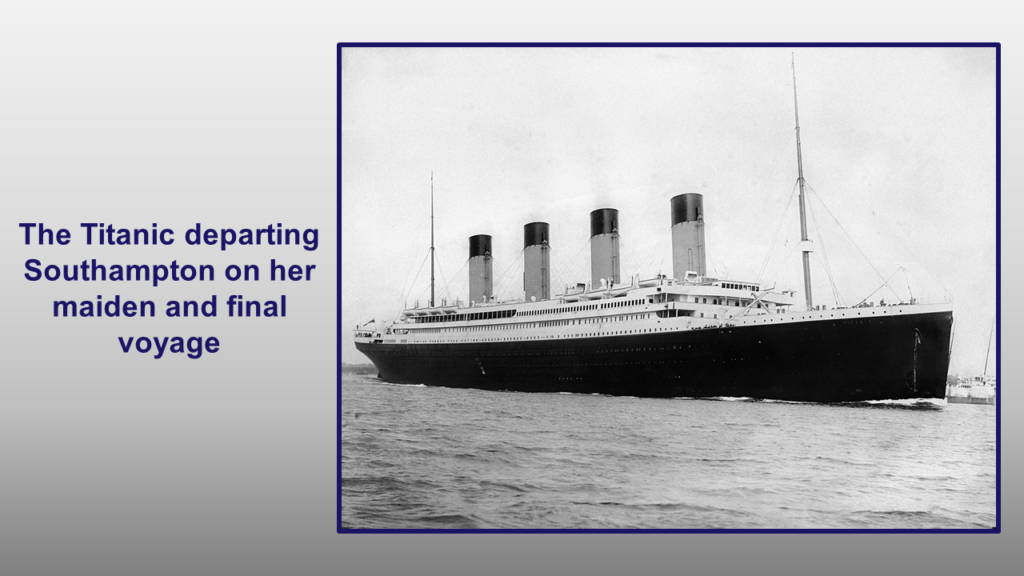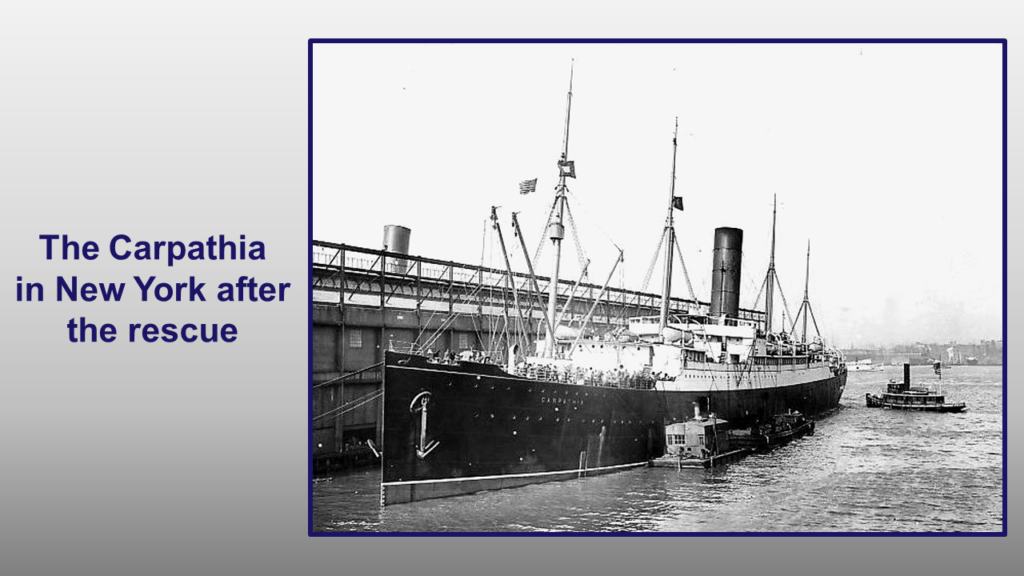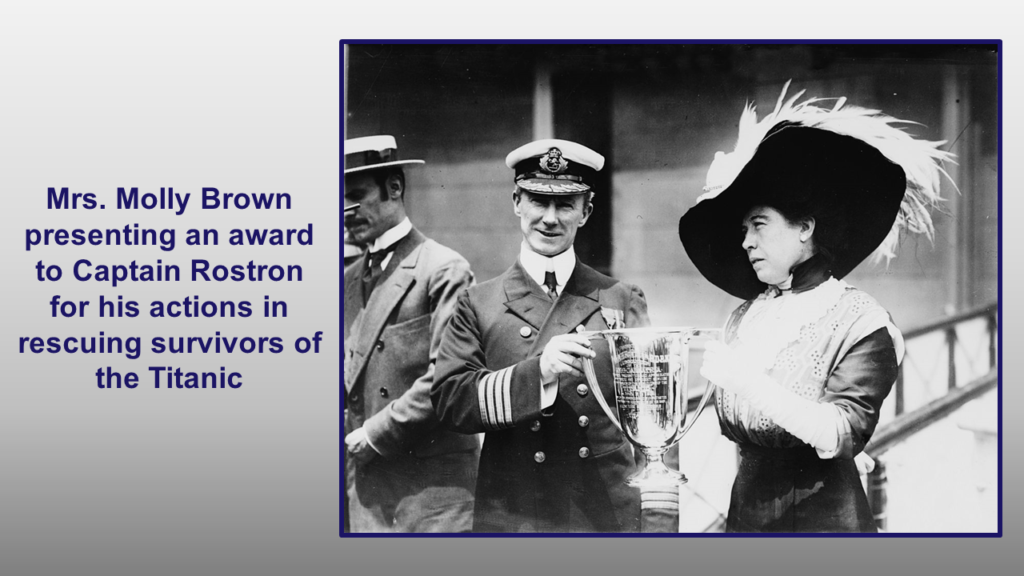Introduction
On the night of the 14th/15th of April 1912, one of the most famous maritime tragedies occurred. The unsinkable White Star Liner the Titanic struck an iceberg and sank within hours taking 1490 people to their deaths.
I would like to take a look at this famous incident, but not from the perspective of the Titanic, but focus on the actions of the captains of two vessels that were in the vicinity.
One that did everything humanly possible to save as many lives as possible, and the other who did not.
They were the Carpathia (Captain Rostron) and the Californian (Captain Lord).
A Titanic Disaster

Around 23:40 the lookout reported an iceberg ahead, and the Titanic took evasive action and went full astern, but it was not quite enough. The ship grazed the iceberg and at first the damage did not seem too severe. However, a hull inspection revealed that 6 of the 9 watertight compartments had been breached and that she was sinking.
Captain Smith had the navigator calculate their position (later information would reveal that the position given was inaccurate), and the radio operator immediately started broadcasting distress calls – CQD – CQD1
Later it was pointed out that there was the recently introduced distress signal (SOS), and the radio operator started using both.
As the situation worsened the lifeboats were prepared and the order given to abandon ship.
Unfortunately, the Board of Trade regulations did not require a vessel to have lifeboat capacity for all persons on board.2 This situation was made worse by the fact that there was no clear system for assigning and loading the lifeboats.
Carpathia
The distress call was received and acknowledged by the Carpathia just after midnight and Captain Rostron ordered a course change. The Carpathia was over 60 miles from the Titanic and would take several hours to arrive on location.
Rostron took immediate action:
- The entire crew was awakened
- All steam was diverted to the engines
- Additional lookouts were posted to warn of ice hazards
- The Carpathia headed for the Titanic with all speed
As she steamed through the night the crew prepared the vessel to receive the survivors of the Titanic, and everything that could be done was done.
- Lifeboats were prepared
- Lights and boarding nets were prepared
- Areas of the ship were prepared to receive survivors
- Food drink and blankets were prepared
- Medical supplies were readied
Californian
Meanwhile a totally different situation was playing out on the Californian.
She had stopped for the night because Captain Lord was concerned about the ice field and was waiting for daylight to navigate it.
The radio operator was asleep. He had earlier attempted to message the Titanic with a report of ice but was abruptly silenced by the harassed operator on the Titanic.
The bridge watch could see a stationary vessel some distance away and reported it to the captain, who ordered an attempt to contact the other vessel by morse lamp. As they continued to watch the unknown vessel started to fire white rockets, which was again reported to the captain, who took no action.
The Titanic eventually fired a total of eight rockets, all of which were ignored. The Titanic crew also attempted to contact the unknown vessel with a morse lamp, but there is no record of a response.
The Titanic sank at around 02:30 without ever establishing contact with the unknown vessel.
Rescue Operations
The Carpathia arrive at around 04:00, and although the reported position was incorrect, they located the lifeboats, when one of them fired a flare. Rescue operations commenced immediately and were completed by around 07:00 with the rescue of over 700 survivors. With his vessel now filled to excess Captain Rostron, made the decision to set course for New York with the survivors.
Meanwhile on the Californian the first officer came on duty and heard the tales of the unknown vessel. He immediately woke the radio operator and instructed him to try to find some information. He quickly learned of the Titanic’s sinking and its final position.
When this information was presented to Captain Lord, he asked for confirmation of the position.
On receiving it he ordered the Californian to proceed to the location, and on route they saw the Mount Temple. They arrive on location and saw the Carpathia on the other side of the ice field having just completed rescue operations. The Californian moved through the icefield to join the Carpathia. Captain Rostron requested Californian remain on location to search for any remaining survivors whilst the Carpathia headed for New York with the survivors.
The Californian remained on location searching for a few hours and then resumed course to her original destination of Boston.
New York

On arrival in New York the crew of the Carpathia had to fend-off reporters who attempted to board with the pilot.
In a slightly quaint incident, the Carpathia first steamed to the White Star line pier and unloaded the Titanic’s lifeboats which had been recovered and stored on deck.
On docking at the Cunard pier their own passengers were first disembarked followed by the survivors.
The Inquiries
It was the hopeful beginning of a new century, and the horrors of the 20th century were yet to come.3 The huge loss of life and the sinking of the unsinkable shocked the essentially Victorian public who demanded answers.
How could Victorian engineering excellence have failed so badly?
US Senate
The US immediately called an inquiry into the disaster headed by Senator Aiden Smith. Officers of both the Carpathia and Californian were subpoenaed and questioned along with surviving members of the Titanic’s crew.
The inquiry took place between April 19th to May 25th, 1912.
British Inquiry
The Board of Trade followed and initiated an inquiry carried out by the British Wrecks Commissioner, presided over by Lord Mersey. It questioned a similar array of witnesses and subject matter experts.
The inquiry ran from the 2nd of May to the 3rd of July and issued a final report on the 30th of July.
Recommendations
Both inquires had similar recommendations and I will outline them together.
Relating to the Titanic:
- All vessels should carry sufficient lifeboats for the entire compliment and have clear procedures for the training of the crew in their use and passenger allocation.4
- There should be a continuous radio watch maintained 24 hours a day.5
- The Titanic was travelling too fast, despite the ice warnings received. Vessels should reduce speed and increase watches.
Relating to the Californian:
- Both inquiries concluded the ship seen by the Titanic was the Californian (and vice-versa)
The Captains

Captain Rostron was hailed as a hero and was presented with multiple awards in recognition of his prompt actions. He would also rise to become the Commodore of the Cunard Line.
For Captain Lord things were different. He lost his command but was never formally charged with anything and retained his master licenses. He was able to regain a command position, but not with the prestige of the Californian, and he never realized his early promise.
He did request further inquiries to clear his name but was never granted one.
Discovery of the wreck
The 1985 discovery of the wreck of the Titanic brought clear proof that the reported position of the sinking was incorrect, and modern day supporters of Captain Lord were able to instigate a new review of the Titanic/Californian question.
Entitled, RMS “Titanic” Reappraisal of Evidence Relating to SS “Californian, by The Marine Accident Investigation Branch, which reported in 1992.
Marine Accident Investigation Branch Report
The final report concluded that there were probably a number of vessels in the area at the time of the disaster.6
It also concluded that vessel seen by the Californian was probably not the Titanic, but a third vessel7. (Which was probably also seen by the Titanic)
The rockets witnessed by the Californian were those fired by the Titanic, but since the third vessel was on the same bearing as the Titanic, they appeared to come from it. (Which would be consistent with them appearing to be low in the sky when viewed from the Californian)
The report is clear that based on the assumed relative positions of the Californian and the Titanic, that even if the Californian had immediately responded to the rockets it could not have reached the area prior to the sinking of the Titanic and could therefore not have saved those who perished. The report conclude that it would simply have performed the rescue operations carried out later by the Carpathian.
It does conclude that the Californian should have responded to the distress rockets.
Similarly waking the radio officer would have led to the discovery of the tragedy and the need for action.
One speculation of why this did not happen is that 2nd officer Stone lacked confidence and did not forcefully advise the captain of the situation. Captain Lord was reputed to be a martinet and Stone did not force the issue when the captain was initially disinterested.
He could have:
- Wakened the radio officer
- Insisted the captain come to the bridge
- Ordered steam-up in preparation for moving
Conclusion
The 1992 report is the final word, for now, and states the following:
- Captain Smith of the Titanic was responsible for the disaster by steaming at speed despite the ice warnings
- The Californian could not have rescued the bulk of those who perished
- The Californian should have taken action and investigated the rockets
- Ice was much further south in 1912 than was normal for the time of year
The discovery of the wreck in 1985 provided new concrete evidence which changed the perceptions of the course of events, but it is unclear if any further evidence will be revealed in the future.
But given the current addiction to conspiracy theories, I am sure that the speculation on Captain Lord and the Californian will continue.
At the time of researching and writing this post PBS screened a documentary on the disaster. (see detail in the bibliography)
What we do know is that one man, Captain Rostron, acted with speed and skill and in the best marine tradition came to the aid of fellow mariners.
How culpable was Captain Lord? We may never know the full story, but he and probably unknown others failed to respond appropriately on that April night in 1912.
Top Lesson for Project Managers
As project managers we are at all times required to make moral judgements as well as technical and fiscal ones.
PMI has clear ethics standards and members, and certification holders are required to be aware of and implement them.
Alankar Karpe in his 2015 paper8 outlines the rational for these ethics standards, and the fact that in the long run they are good for business.
I am sure that many of us have on occasion done the expedient thing, and not followed the standards exactly. Minor things but if we do not hold ourselves to account, we will erode our standards, and potentially cause harm to ourselves, our organisation, and the general public.
What can we do?
- Continually update our risk management analysis to match current events.
(Captain Smith did not modify his assessment of the risk in light of the current reports of ice hazards but proceeded based on normal patterns and practices. This may not sound like an ethical issue, but he had a duty to protect his passengers and crew and not focus on meeting sailing schedules.)
- Create a work environment where it is safe for team members to speak-up and act ethically
- Be familiar with the PMI Ethics Standards and consider them when making project plans and decisions.
- Speak out and support those who are under attack for doing or saying the right thing.
A quotation from the writings of the Bahá’í Faith comes to mind as something that is totally relevant to everyday secular life. If we continually bring ourselves to account each day on ethical matters we need not worry if we have to appear at a public inquiry, similar to the one attended by the officers in the above account.

I had intended to review the PMI ethics standards and the ethical decision-making framework, but in the words of Robert Burns; “Nae man can tether time nor tide”,
So that will have to be for another post.
NOTES
1CQD was the recognized distress signal before SOS. CQ – All Stations; D – Distress
2The Titanic had more lifeboats than required by the regulation, but there were still far fewer than required for all onboard.
3Both the Carpathian and the Californian would follow the Titanic to the bottom a few years later, victims of German U-Boats, in the even bigger horror of “The Great War”.
4This resulted in the structure we have today where vessels have more lifeboat capacity than required, with rigid training and assignment procedures. The convoys of WWII showed that the use of open lifeboats was insufficient, because many who survived the sinking died of exposure in the harsh North Atlantic, resulting in the use of enclosed lifeboats and life rafts.
5When I attended a Marine Radio Officer course in the 1970s, we covered the use of automated receivers which detected an SOS message and alerted an off-duty radio officer. (For vessels with a single radio officer).
6Shipboard radio was a relatively new technology, and many vessels did not have it and probably sailed on by totally unaware of the tragedy.
7The Mount Temple is a candidate for a third vessel
8 ProjectManagement.com – Being Ethical is Profitable (Requires PMI login)
9The Hidden Words of Bahá’u’lláh
BIBLIOGRAPHY
- The Other Side of the Night – Daniel Allen Butler
- NPR’s Abandoning the Titanic
(Aired November 4th ,2020 – Available until December 31st, 2020
Secrets of the Dead | Abandoning the Titanic | Season 18 | Episode 6 | PBS
- RMS “Titanic” Reappraisal of Evidence Relating to SS “Californian – Marine Accident Investigation Branch (UK – 1992)
https://assets.publishing.service.gov.uk/media/54c15bf240f0b6158d000027/MAIBReport_ReappraisalOfEvidence-SSCalifornian-Titanic-1992.pdf
- Being Ethical is Profitable – Alankar Karpe

Superb article Jim!
Admire the way you research, present new perspectives, and extract lessons for project managers.